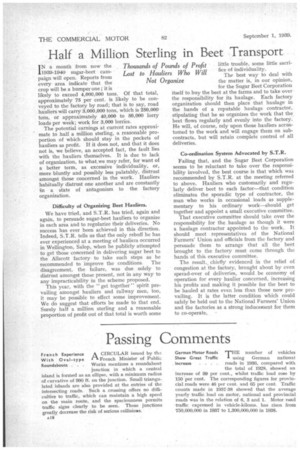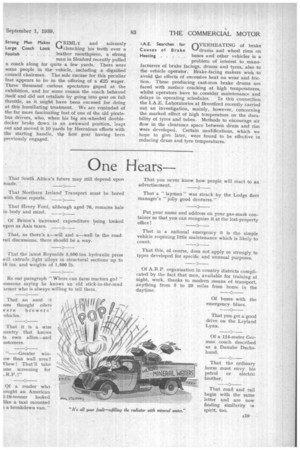Passing Comments
Page 20

Page 21

If you've noticed an error in this article please click here to report it so we can fix it.
French Experience A CIRCULAR issued by the With Oval-type r-k French Minister of Public
Roundabouts . Works mentions a roundabout junction in which a central island is formed as an ellipse, with a minimum radius of curvative of 990 ft. on the junction. Small triangulated islands are also provided at the entries of the intersecting roads. Such a crossing oilers no difficulties to traffic, which can maintain a high speed on the main route, and the spaciousness permits traffic signs clearly to be seen. These junctions greatly decrease the risk of serious collisiols.
German Motor Roads THE number of vehicles Show Great Traffic I using German national
Increase . . . . roads in 1936, compared with
the total of 1928, showed an increase of 99 per cent., whilst traffic load rose by 150 per cent. The corresponding figures for provincial roads were 46 per cent. and 65 per cent. Traffic counts made in 1937-38 showed that the average yearly traffic load on motor, national and provincial roads was in the relation of 6, 3 and 1. Motor road traffic expressed in vehicle-kiloms. has risen from 750,000,000 in 1937 to 1,300,000,000 in 1938. GRIMLY and solemnly clenching his teeth over a leather mouthpiece, a strong man in Sleaford recently pulled a coach along for quite a few yards. There were some people in the vehicle, including a dignified council chairman. The sole excuse for this peculiar feat appears to lie in the offering of a £25 wager. Three thousand curious spectators gaped at the exhibition, and for some reason the coach behaved itself and did not retaliate by going into gear on full throttle, as it might have been excused for doing at this humiliating treatment. We are reminded of the far more fascinating feat of one of the old piratebus drivers, who, when his big six-wheeled doubledecker broke down in an awkward position, leapt out and moved it 10 yards by Herculean efforts with the starting handle, th,e first gear having been previously engaged.
Strong Man Makes Large Coach Look Foolish . .
1.A.E. Searches for nVERHEATING of brake Causes of Brake •-fdrums and wheel rims on
Heating buses and other vehicles is a problem of interest to manufacturers of brake facings, drums and tyres, also to the vehicle operator. Brake-facing makers wish to avoid the effects of excessive heat on wear and friction. Those producing cast-iron brake drums are faced with surface cracking at high temperatures, whilst operators have to consider maintenance and delays in operating schedules. In this connection the I.A.E. Laboratories at Brentford recently carried out an investigation, mainly, however, concerning the marked effect of high temperature on the durability of tyres and tubes. Methods to encourage air flow in the clearance space between drum and rim were developed. Certain modifications, which we hope to give later, were found to be effective in reducing drum and tyre temperatures.




































































